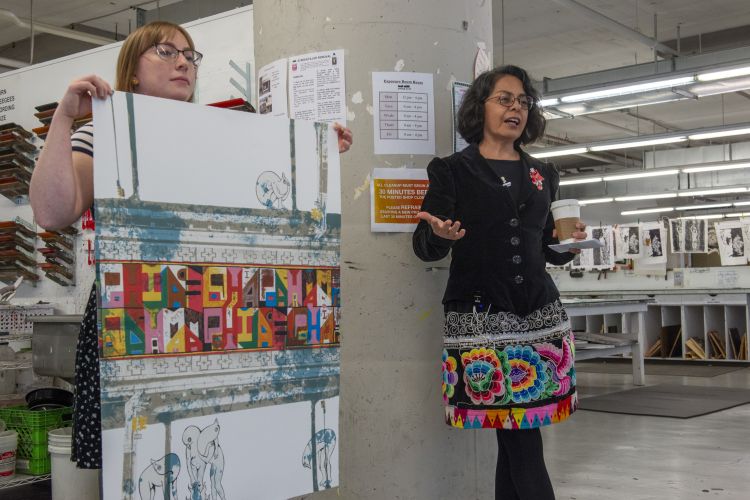STORIES FROM PAFA
Using Economic Models to Create Art
Billowing white wedding dresses are crumpled in the corner of Katie Weidlein’s (MFA ’19) studio waiting for a new design.
Weidlein embroiders marriage market models onto the dresses, juxtaposing the emotionally charged dresses with examples of behavioral economics. The models attempt to predict the number of marriages.
It’s a unique pairing but combining art with economics comes naturally to Weidlein. She double majored in the two at Lafayette College.
“I always loved art, since I was little, and then I just randomly decided to take economics,” she said. “I think in a weird way I’ve always been right and left brain thinking with a lot of different things.”
Weidlein said she appreciates the cleanliness of economics, stripping away the reality and focusing on the logic of a model.
Much of her artwork focuses on consumption: the wedding dresses and drawings of desserts and women’s bodies. Consumption is a major concept in economics so it was a natural fit to bring the social science into her art practice and make sense of complicated emotions and topics.
“I always found it really strange that you’re trying to break down something that’s so real, and has so many emotions wrapped up, into this scientific linear chart,” she said.
She says her approach to making art is more logical than the usual stereotype of an artist.
“It’s the myth of the artist that they’re locked away in a tower getting divine inspiration and painting or something like that,” she said. “It’s funny because when I was younger and didn’t just have inspiration, I used to think something was wrong with me. You eventually learn how not true that is and you learn, ‘I am normal, this is part of the process’.”
She works hard at PAFA to push herself to keep creating, whether it involves stopping at a thrift store on South Street to buy wedding dresses the day before Valentine’s Day or studying cadavers in a medical lab to improve her figure drawing skills.
“I am thinking about art constantly and I think it’s led to a lot more rapid change,” she said. “I probably changed here in the first few months more than I ever did my whole undergrad, which is a good thing because I do think my work has gotten stronger.”
In addition to making more and better work, Weidlein has also loaded up her schedule with PAFA’s graduate class offerings. She’s dabbled in Lo-Fi Translation, Intro to Avant-Garde Practices, and the aforementioned cadaver drawing.
She said the experience of drawing the deceased was a lot to process at first but she has since made peace with the experience.
“It’s an amazing opportunity because I didn’t know how much it would affect my figure drawings,” Weidlein said. “But when you look at how things are attached and what is not inside, then you start to understand how and why the body works the way it does and the your drawings are better.”
After graduation, Weidlein wants to continue exploring and eventual share what she’s learned with others.
“My ultimate goal is to one day be a professor and teach drawing classes, especially intro classes and of course keep making work, obviously,” she said. “I would also really like to possibly have a museum job, I want to try a lot of things. I know life isn’t a straight path.”
We're so excited you're planning to visit PAFA!
Make time for art — visit us Thursday to Sunday.
Before reserving your tickets, please review helpful information about museum hours, accessibility, building access, and special admission programs.
If you have any questions, feel free to reach out to us at visitorservices@pafa.org — we’d love to help!




